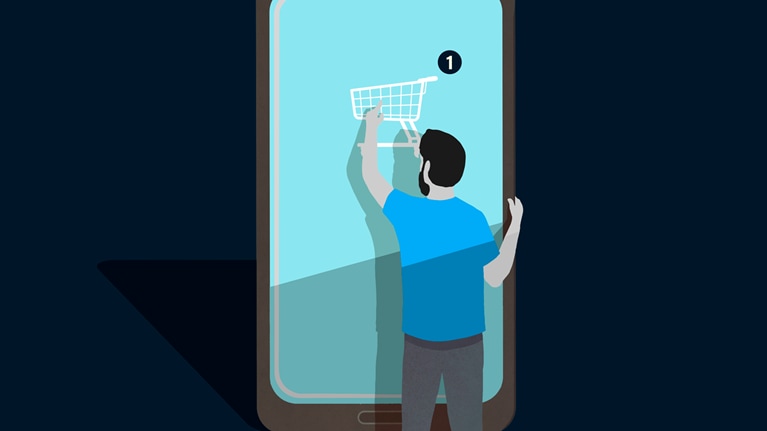The retailer of the future doesn’t just sell products on shelves—it offers services that affect many parts of consumers’ lives, from their healthcare and finances to their travel and entertainment choices. Indeed, today’s retailers would do well to venture beyond the traditional bounds of retailing if they hope to remain relevant and competitive in the years ahead.
The following are excerpts from a recent McKinsey webinar on how retailers can expand into service businesses and, ultimately, build ecosystems that attract and retain loyal customers. Speaking at the webinar were Marco Catena, a McKinsey partner based in Milan who leads an initiative called “Beyond Retail”; Richard Mayfield, a former regional CEO at Walmart and CFO at Asda; and Rakhi Williams, formerly a strategy executive at Tesco.
Why go beyond retail?
Marco Catena kicked off the webinar with an explanation of why retailers should play offense when it comes to developing new service businesses. He also presented survey results that suggest that enough consumers are willing to abandon their current service providers and switch to retailers’ service offerings instead.
Marco Catena: We are all aware that we are in a time of great disruption. There is increasing pressure on profitability and return on capital, but at the same time, there is a need for new growth opportunities to ensure a sustainable future. Now retailers have the opportunity to play offense by entering into new service categories with a higher level of profitability, as digitization and technology today enable more accessibility for consumers. Technology is blurring industry lines, allowing different operators—including retailers—to address these opportunities more rapidly and effectively by getting in contact directly with consumers.
Retailers have the opportunity to play offense by entering into new service categories with a higher level of profitability, as digitization and technology today enable more accessibility for consumers.
But is the value at stake significant? Yes—we believe that retailers can achieve up to 20 to 30 percent additional growth [Exhibit 1]. We can really see an acceleration potential in the level of profitability in the new ecosystems.

Richard Mayfield: It’s no secret to anybody that we’re in the middle of a crisis. Inflation is the highest it’s been for 50 years, and it’s broad-based across food, commodities, energy, labor. The pressure on consumer spending, on supply chains, and on retailers’ cost bases is severe—and it will continue. So the first priority is responding to those challenges. I wouldn’t be looking at additional growth opportunities until I was confident that my core business is healthy, my proposition is competitive, my customers are happy, and my balance sheet is healthy.
But it’s also true that these times present opportunities. If you look back at previous recessions, in the five to seven years coming out of recessions, you see the most trading of market share of any other time. It’s partly because consumers are changing their behavior more quickly—changing where they shop, changing brands—and that spells opportunity.
Marco Catena: We completed a survey this summer, interviewing more than 6,000 consumers across Europe [Exhibit 2]. The survey shows something very interesting: 20 percent of them are not satisfied with their current service provider. There are two elements that came up. One, 70 percent of consumers are looking for more value for money. At the same time, they are seeking more accessibility and higher quality of service.

We also tested customer willingness to approach retailers for such services, and 60 percent, on average, stated that they would buy from retailers. Furthermore, high-income customers1 are more willing to switch toward retailers. This is probably because they are typically more open to innovation. However, one insight that emerged from the survey is that a retailer needs to have a trusted relationship with consumers in order to win beyond the core.
Retail media networks
Some B2B services are becoming big business for some large retailers. One such service is advertising and marketing: retailers are starting to act like media companies. Here’s what Rakhi Williams and Richard Mayfield had to say about retail media networks.
Rakhi Williams: It started in the US. We’re starting to see a shift toward what we call retail media networks. Retail companies are starting to understand the benefits of playing as a media company.
Retailers have a few assets that place them well to start leveraging new revenue streams. The first one is audience and traffic. Many large retail players have millions of customers visiting their sites on a daily basis. They are collecting huge amounts of granular data on customer behavior and intent.
They have a huge number of channels to reach customers: their online presence, stores, catalogs, and social media. They have screens in their stores. And they have content. Some of it is just the regular product content, but more sophisticated retailers are starting to understand the power of leveraging their brand, creating compelling content, and driving audience engagement through that content. And then, retailers have reach, not just through their own networks but also through paid and affiliated networks, mobile, and so on.
All of these assets together allow many retailers—like Best Buy, Walmart, and Target—to leverage these media assets. They’ve realized that they can drive very strong lead generation machines that add a huge amount of ancillary revenue. We know that disruption is the new normal and that retail is a real battleground, so it’s crucial for retailers to have a second engine. That’s where these new services and retail media networks come into play.
The difficulty now is, as Richard touched on, rising interest rates. We forget that the past ten years have been a playground for investment fueled by low interest rates. It was inexpensive to finance new activities, to experiment and fail. We’re not seeing that anymore.
With pressure on margins, you see retail companies “firefighting.” Growth is not top of mind, right? But, like Richard said, resilient companies invest during tough times, and building new businesses takes a long time. Those that don’t do it get left behind.
Richard Mayfield: The point of B2B is to leverage assets you already have; you’re creating value from assets that already exist. Retail media networks and advertising are relatively easy for retailers to develop. If you have the right customer base and the right technology capability, then it’s really just about making an investment in some advertising capability and knowledge to build that business. There’s not a lot of capital investment required.
One thing that’s differentiated about advertising in retail is that you can help customers. We all know that’s not true for a lot of advertising in other places. You’re watching something, maybe a video that you’ve downloaded, and you’re forced to watch some advertising up front. You’re not interested in buying the thing that’s being advertised; you just want to get past the advertising. But in a retail space, you can identify the moment that customers are thinking about something, and you can help their decision process. You have data that allows you to put advertising in front of customers that actually helps them. What a crazy thought.
Ultimately, it’s about understanding and connecting the data on your customers so that it allows you, on the one hand, to give them better and more personalized experiences and, on the other hand, to create data that can be monetized through some of these new B2B businesses.
Rakhi Williams: I think the main thing that retailers need to do is not just use the customer data they have but go one step further and look for signposts that start to show shifts that are happening—almost anticipating where customers are going. Because, as the cliché goes, the pace of change will never be this slow.
A road map for retailers
Since retailers have all these opportunities and assets, how should a retailer choose which services to offer? Marco Catena suggested three lenses that retailers can use when assessing new services. Rakhi Williams then talked about what’s next in the world of retail ecosystems, and Richard Mayfield discussed the core capabilities that retailers need in order to succeed in retail ecosystems.
Marco Catena: We strongly believe that retail, in the future, will require a substantially different playbook. Exhibit 3 shows the four components or steps in that playbook.

The first is a solid omnichannel infrastructure. That is a must, of course, for capturing share of wallet in a retailer’s core business, whether it’s food or nonfood. It’s the foundation of a modern retailer. The second step is the development of a service proposition—one that is consistent with the product proposition—that can respond to and solve the unmet service needs of your loyal customer base. The third step is the creation of physical or digital assets—whether that’s data, logistics, IT infrastructure, you name it—and these can serve either a B2C or a B2B purpose.
Then, once you’ve gone through those three steps, you can start the monetization model or the engine of monetization. This can deliver superior financial performance; it can be a self-reinforcing mechanism to provide more value to the entire system but also to recover profitability in difficult financial situations.
Let's focus on the second step: the new services. What are the criteria? What are the principles for defining the right set of services for a retailer? We believe there are three lenses. The first, which is very important, is that the right portfolio of services will be based on a detailed understanding of the loyal customer base—in particular, how relevant the services are to them and whether there are unmet needs that you as a retailer can fulfill. Second, a new service should be profitable or allow for further monetization—so it can be marginal in terms of profitability, but it should create some assets that reinforce the entire ecosystem. Finally, the selection should not be random but clearly and coherently match the brand values, purpose, and capabilities of the company.
Rakhi Williams: I think an upcoming concept, when talking about retail ecosystems and services, is the concept of community. The percentage of the global population actively online is consistently increasing, so the concept of community has become really important: “I want to identify with a brand; I want a brand to see me; I want to be understood; I want that brand to know me.” When retailers invest in this concept of community, they connect with their customers on the deepest levels. They build relationships that drive loyalty, which, in turn, drives sales.
When retailers invest in this concept of community, they connect with their customers on the deepest levels.
The other interesting demographic shift that’s made community really powerful is the rise of the millennial generation. They really identify with authenticity, brand awareness, brands speaking to them.
Retailers need to think about how to build a strong proposition around their authentic brand: What are their brand values, and how do the communities identify with those brand values? What can they do to augment their communities both physically and online? What kind of compelling content can they create to drive the audience? What can they do in between—when their community isn’t on their website? How can they reach them through compelling content via newsletters—newsletters that you actually want to click on? How do they engage social media?
The point is, once you have a loyal community, they’ll follow you in the ecosystem. It’s much easier, then, to launch brand extensions and new businesses.
Richard Mayfield: The first capability a retailer needs to succeed in this new world of retail ecosystems is a really deep understanding of its customers—real customer centricity within the organization. That’s always been a feature in Walmart—asking the question, “How does the customer feel about this?” all the time—but it’s become more and more crucial. The second is—and I hate using the words “digital transformation” because everybody does—shifting your culture so that everybody throughout the organization goes through all kinds of relearning around digital leadership, understanding technology, understanding microservice-based architectures and how to use them to develop your business. The third is, whatever retail channel you’re in, be the best in the supply chain.
Those are the three capability areas you need to focus on if you want to build an effective ecosystem. There are some specific capabilities you need depending on which services you go into, but I would pick those three as areas that you absolutely need to drive through every element of your business—every function, every person—as a deep part of your culture.
The ‘right to win’
At the end of the webinar, Rakhi Williams and Richard Mayfield offered a few parting words of advice.
Rakhi Williams: We’ve talked about how difficult the environment is right now and that growth may be the last thing retailers are thinking about, but I think there needs to be an innovation mindset and an entrepreneurial mindset, like the one that very much drove Tesco in the days when I was there. It launched into every kind of new business one could think of—and that is around an MVP [minimum viable product] model.
You don’t need to acquire a large business. You don’t need to spend lots of money. You can sweat your existing assets. You can get your feet wet and build up experience through strategic alliances, commercial partnerships, joint ventures. Hopefully, the current environment won’t hold companies back from experimenting and trying new things.
Richard Mayfield: It all has to start with a really deep understanding of the customer base: where they spend their money, where they spend their time, and their particular pain points. In some of those spend areas, how well are they served? How easy is it to use those services? Is the pricing effective and efficient?
Out of that analysis, you’ll come up with some opportunities. Do you believe that, with your combination of assets and capabilities, you have a “right to win” in that market? I certainly wouldn’t go for a proliferation of efforts, but innovation is critical. Focus on the customer. Find an area you think you’ve got a right to win—and move quickly at it.


